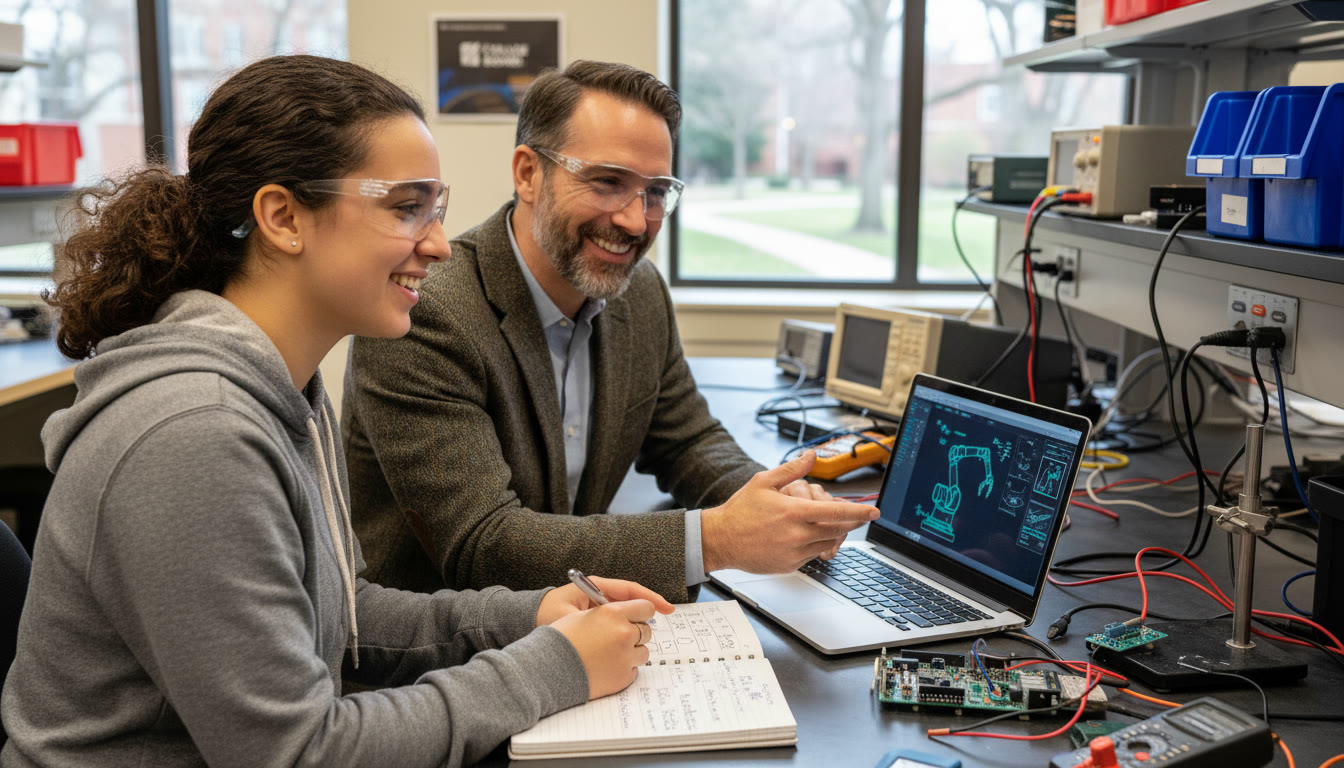AP Credit and ABET-Accredited Programs: Why This Conversation Matters
Walk into any kitchen table conversation about college and you’ll probably hear the words “AP” and “credit” tossed around. For students aiming toward engineering or other STEM majors, one more important phrase often appears: “ABET-accredited.” Put together, AP credit and ABET accreditation form a practical crossroads — a place where high school preparation meets rigorous college curricula. This guide is for students and parents who want a clear, warm, and tactical view of how AP credits might fit into ABET-accredited programs, what to expect, and how to make decisions that save time, money, and stress.

Quick overview: AP Credit in plain language
Advanced Placement (AP) exams allow high school students to demonstrate college-level knowledge in a subject. Colleges may grant credit, placement, or both based on AP scores. That can mean skipping introductory coursework, placing into higher-level classes, or fulfilling general education requirements. The precise benefit depends on two things: the AP score you earn and the college’s policies.
What ABET accreditation means for students
ABET is an accreditor for college and university programs in applied and natural sciences, computing, engineering, and engineering technology. When a program is ABET-accredited, it has met a set of criteria that ensures graduates are prepared to enter their professions with the necessary technical knowledge, problem-solving abilities, and ethical foundations. For students, that translates into a predictable and standardized educational experience — important for licensure, industry recognition, and graduate study pathways.
How AP Credit and ABET Programs Interact
The relationship between AP credit and ABET-accredited programs is nuanced. AP exams can help you get ahead, but ABET programs are often structured, sequential, and intensive — especially in the first two years. That means colleges may be cautious about how much core engineering content they will allow to be skipped.
Common ways colleges apply AP scores in ABET programs
- Credit for general education or math/science courses (e.g., calculus, chemistry, physics).
- Placement into higher-level classes so you skip prerequisites but still take required core classes later.
- Limited or no credit for technical core engineering courses — colleges often prefer students to take core engineering classes within their ABET curriculum to ensure consistency in outcomes.
Two typical scenarios
Understanding these two scenarios helps in planning:
- Scenario A — Credit and acceleration: A student earns strong AP scores in Calculus and Physics, receives college credit, places into higher-level math or physics courses, and uses the freed-up semester hours to take advanced electives, undergraduate research, or internships.
- Scenario B — Placement without credit: A student places into a later class (so they don’t repeat content), but the college still requires them to complete the core credits inside the ABET program. The benefit is time saved on review, but the transcript still shows the full program of study.
What matters most when planning AP strategies for ABET programs
Not all AP credits are created equal for engineering and ABET programs. Here are the practical factors students and parents should prioritize.
1. The AP subject and score
Math and science APs — think Calculus, Physics, Chemistry, and Computer Science — are the most valuable for engineering pathways. A high score (typically a 4 or 5 at many institutions) increases the chance of receiving credit or advanced placement. Still, some colleges accept a 3 for partial credit or placement in certain courses.
2. The college’s AP policy
Every college sets its own rules: what score thresholds they accept, which courses receive credit, and whether AP can fulfill major-specific requirements versus only general education. Always check the admitting institution’s policy early — it directly influences which APs you should prioritize in high school.
3. The structure of the ABET curriculum
ABET-accredited programs often feature tight progressions: introductory engineering, labs, design projects, and professional seminars are sequenced to build on shared foundations. A skipped prerequisite might seem convenient but could require careful planning to ensure you still meet the required learning outcomes.
4. Career and licensure goals
If you aim for professional licensure (like becoming a Professional Engineer in the U.S.), graduating from an ABET-accredited program is usually essential. AP credit doesn’t replace the accreditation — it just potentially reduces time in college or allows earlier access to advanced topics.
Practical benefits and trade-offs
AP credit can create real advantages, but also some trade-offs. Below is a balanced look so families can weigh choices intelligently.
Benefits
- Save money and time by earning college credit in high school.
- Accelerate into advanced coursework, undergraduate research, or dual degrees.
- Gain flexibility to explore minors, take lighter semesters during internship seasons, or study abroad.
Trade-offs and considerations
- Skipping foundational courses may mean missing local curriculum alignment — instructors may assume shared exposure to certain examples or lab experience.
- Some ABET programs limit credit for major core classes to preserve outcome uniformity.
- Too many skipped credits early can leave you without meaningful electives later in your degree plan.
How to plan smart: a step-by-step action plan
Here’s a practical checklist students and parents can follow, from junior year of high school through the first year of college.
Junior year (or earlier)
- Identify target majors and a list of prospective colleges with ABET-accredited programs.
- Prioritize AP subjects aligned to STEM goals: Calculus, Physics, Chemistry, Computer Science, and Statistics.
- Start a study rhythm for AP coursework and consider practice exams to diagnose strengths and weaknesses early.
Senior year / application season
- Research each college’s AP credit policy and note the required scores and any restrictions for major credit.
- Use college visits and admissions officers to ask program-specific questions: “Will AP Calculus count for MATH 101?” or “Does AP Physics exempt the Intro Lab?”
- Consider taking subject-specific advanced coursework or community college classes if AP credit will not be accepted for certain key courses.
After acceptance / before enrolling
- Request a course-by-course evaluation from the registrar or the department (some colleges will do a preliminary AP credit evaluation).
- Plan your first-year schedule with academic advising. If you scored well on AP exams, discuss whether to place into higher-level sequences or to take the baseline ABET course for cohesion.
First year of college
- Confirm official credit postings on your transcript and ensure any missed steps in evaluations are completed before add/drop deadlines.
- Talk with faculty mentors about how AP placement can be leveraged for undergraduate research, co-ops, or honors coursework.
Sample course credit matrix
The table below is a simplified example to show how AP exam results might map to college course outcomes in a typical ABET-focused engineering pathway. Real policies vary, but this gives a snapshot of possibilities.
| AP Exam | Common Score Threshold | Possible College Outcome | Impact on ABET Program |
|---|---|---|---|
| Calculus AB/BC | 4–5 | Credit for Calculus I (and possibly II) or placement into higher math | Saves core math hour(s); allows earlier engineering math electives |
| Physics C: Mechanics / E&M | 4–5 | Placement or credit for Introductory Physics with calculus | May permit skipping introductory lecture but lab credit varies |
| Chemistry | 4–5 | Credit or placement for General Chemistry | Lab requirements sometimes still required within ABET program |
| Computer Science A | 4–5 | Credit or placement for introductory CS programming | Helpful for CS-rich engineering majors; may open advanced electives |
| Statistics / Other | 3–5 (varies) | Possible general education credit or elective placement | Useful but often less central to ABET core than calculus/physics |
Real-world examples and common questions
Below are some practical scenarios students often face, with advice that balances aspiration and realism.
Q: If I place out of Calculus I with an AP score, can I skip the engineering math sequence?
A: Usually you can skip introductory calculus and move into a later course, but many ABET programs will still require specific applied math or engineering math courses within the curriculum. Discuss placement with your academic advisor to make sure your choices don’t create future gaps.
Q: My AP Physics score is high — will that waive lab requirements?
A: Not always. AP exams can demonstrate conceptual mastery, but ABET-accredited programs place high value on lab-based learning outcomes. Some programs allow lab exemptions, others require you to take college labs to ensure uniform skill development.
Q: Is it better to take more APs or fewer very well?
Quality over quantity. Strong scores on strategically selected APs (calculus, physics, computer science) are far more useful for ABET-track students than a long list of lower scores. Admissions and credit both value depth of preparation.
How personalized tutoring can help — where Sparkl fits
Preparing for AP exams with targeted support can transform study time into meaningful advantage. Sparkl’s personalized tutoring focuses on 1-on-1 guidance, tailored study plans, expert tutors, and AI-driven insights — helping students not just memorize, but truly understand core concepts in the way college programs expect. That means:
- Clear, exam-focused routines that boost confidence and scores.
- Subject-matter tutors who connect AP content to college-level applications.
- AI-powered diagnostics that show which skills need attention and how to spend limited study time most effectively.
When applied thoughtfully, tutoring helps students aim for the right APs, prepare for placement conversations, and get the most out of their early college experience.
Tips for parents: coaching without doing the work for them
Parents play a vital role in supporting decisions and logistics. To be most effective:
- Help your student research AP policies at their prospective colleges, but let them lead conversations with admissions or department advisors where appropriate.
- Encourage a balanced schedule — rigorous coursework and AP prep are important, but so is rest, extracurricular depth, and mental health.
- Consider targeted investments: a few months of focused tutoring for a pivotal AP (like Calculus BC or Physics C) can yield disproportionate benefits.

Planning for the long term: graduation, internships, and licensure
AP credit is one piece of a larger professional puzzle. If you’re aiming for internships, co-ops, graduate study, or licensure, consider how the timeline of your degree interacts with those goals. Using AP credit to accelerate can allow earlier internships or a stronger resume by senior year. Conversely, some students prefer the security of taking foundational courses within the ABET program to ensure consistent mentorship and lab experience.
Internships and co-ops
Graduating into a competitive internship often depends on demonstrated project experience. If AP credits free up time in your schedule, use it for hands-on experience — join a research group, participate in design teams, or pursue a summer co-op.
Graduate school and licensure
Graduate admissions and professional licensure typically look to core coursework and outcomes rather than how early credits were earned. The important thing is competency: AP credits should be used to strengthen your opportunities, not to shortcut essential preparation.
Final checklist before you hit submit on that AP exam or college enrollment
- Confirm the specific AP-to-credit policy for each college on your final list.
- Decide which APs directly support your ABET-track major and prioritize those.
- Plan time for hands-on learning: labs, projects, internships, or research.
- Use advisors and faculty conversations to map how AP placement affects degree trajectory.
- Consider targeted tutoring or coaching (like Sparkl) for high-leverage AP subjects.
Parting thoughts: smart, not rushed
The most successful students and families treat AP credit as an opportunity rather than a prize to hoard. For ABET-accredited programs, that means using AP results strategically: to reduce redundancy, accelerate genuine learning opportunities, and make space for the experiences that actually matter in engineering and STEM careers. A wise blend of ambition, careful research, and guidance — academic advising, faculty mentorship, and targeted tutoring — will deliver the best outcomes.
If you’re preparing for AP exams and aiming at an ABET-accredited program, start by mapping scores to college policies, talk early with advisors, and consider focused support for the high-impact subjects. With the right plan, AP credit becomes a tool to build depth — not a shortcut away from it.
Good luck, and remember: strong foundations open the most doors. Thoughtful AP planning today can mean richer choices and more meaningful opportunities tomorrow.



















No Comments
Leave a comment Cancel